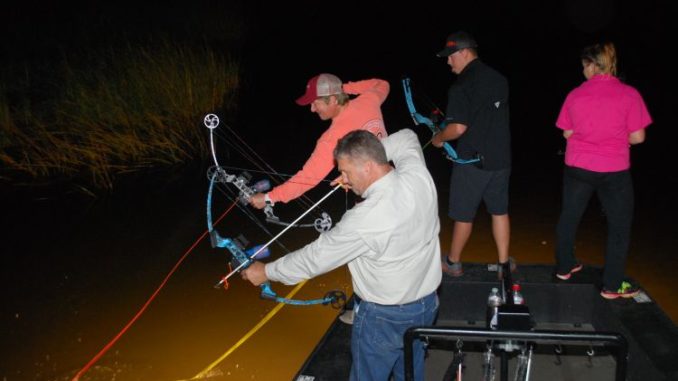
With a little coaching, bowfishing techniques are easy to learn, even for the most inexperienced.
Both Roy Lally IV and Lindsay Schultheis have spent a lot of time working as deckhands/coaches for After Hours Bowfishing, and they were full of advice.
The first thing to keep in mind, they explained, is that bowfishermen must factor refraction into their shooting.
Simply put, a fish under water is not where the human eye perceives it to be.
Light waves travel at different speeds through gases (the air) and liquid (water), as well as through transparent solids such as glass. When the waves move from one medium to another, the waves’ speed is altered, essentially causing them to bend.
The end result is that, when viewed from above the surface, a fish is actually deeper than it appears to be. As a rule of thumb for average bowfishing depths, a shooter should aim 4 to 6 inches below the fish.
The deeper the fish is, the lower the shooter should aim.
If a fish’s fin is breaking the surface, the archer should shoot for its belly. If not so aimed and the fish sinks just a little bit, the arrow will pass over the fish.
The average fish spotted during our trip was swimming slowly, not sitting still. Often everybody on the bow loosed an arrow at the same fish; the best shot was usually the first one taken.
Contrary to the belief that fish are frozen in a blinding light, the fish were aware that the boat was there and were wary.
Occasionally, Louisiana’s marshland waters become very clear, but most of the time they look the same at night as they do in daylight — murky green.
So, rather than look for a whole fish, bowfishermen are told to look for a “glow.”
Redfish have an orangish glow. Sheepshead look like white dinner plates glowing with black stripes. Drum show a whitish glow.
Sheepshead are the toughest to shoot. When spooked, they seldom offer a second shot.
“They take off 100 mph,” Lally laughed.
In spite of dingy water and refraction, shooting undersized fish isn’t really a problem. With customers on the boat, the deckhand is always hovering behind the shooters.
“If we see them draw on an undersized fish, we tell them, ‘Don’t shoot,’” Lally said.
“Customers learn real quickly,” Schultheis said.
And refraction also helps weed out smaller fish.
“… (F)ish in the water always look smaller than they really are, so more often people pass on fish that are legal-sized than shoot undersized fish,” Lastrapes said.
